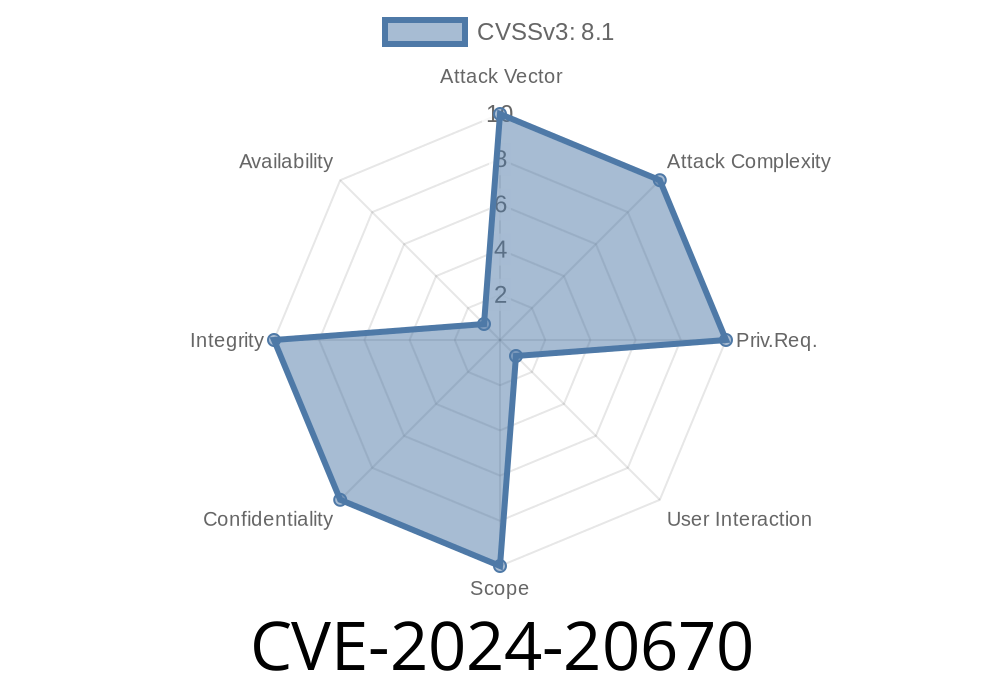Microsoft Outlook, one of the most popular email clients in the world, has recently been discovered to have a spoofing vulnerability that could potentially impact its millions of users. The vulnerability has been assigned the identifier CVE-2024-20670, and it originates from Outlook for Windows. This article aims to provide detailed information about the exploit, along with its consequences and possible solutions. We will also examine code snippets related to the vulnerability and provide reference links for further research.
The Vulnerability: CVE-2024-20670
CVE-2024-20670 is a spoofing vulnerability specifically affecting the Outlook for Windows client. Spoofing attacks are a type of cyber threat, where an attacker poses as a legitimate user or system to deceive the recipient and obtain sensitive information, bypass security measures, or distribute malware. In this particular case, the vulnerability could allow an attacker to spoof the sender's email address, making it appear as if the email originated from a trusted source.
The exploit targets a specific functionality of Outlook for Windows that does not correctly validate the sender's email address when displaying the email in the recipient's mailbox. This lack of proper validation has made it possible for attackers to exploit this weakness and successfully deceive unwary email recipients.
Code Snippet
To better understand the exploit, let's take a look at a code snippet that demonstrates how the spoofing vulnerability can be exploited. Assume that Alice is the attacker, and she wants to send an email that appears to come from Bob, a trusted source in the organization:
from email.mime.text import MIMEText
from email.mime.multipart import MIMEMultipart
def create_spoofed_email():
# Create a new multipart message object
msg = MIMEMultipart()
# Set message headers
msg['From'] = '"Bob" <bob@example.com>'
msg['To'] = 'victim@example.com'
msg['Subject'] = 'Important Information'
# Insert the actual spoofed email address
msg.attach(MIMEText('X-Sender: alice@example.com', 'plain'))
# Attach the email body
email_body = 'This is a malicious email attempting to impersonate Bob.'
msg.attach(MIMEText(email_body, 'plain'))
return msg
In this example, Alice creates a new email message and sets the From header field to make it appear as if the email was sent by Bob. However, the actual sender's email address, 'alice@example.com', is inserted into the message using the X-Sender field. Due to the spoofing vulnerability in Outlook for Windows, the recipient will see the email as originating from Bob, even though it was actually sent by Alice.
Original References
For more information on CVE-2024-20670 and the related vulnerability disclosure, please refer to the following sources:
1. CVE-2024-20670: NIST National Vulnerability Database
2. Microsoft Security Update Guide: CVE-2024-20670
Consequences of the Exploit and Solutions
The potential consequences of CVE-2024-20670 are quite severe. Attackers can use this vulnerability to gain unauthorized access to sensitive information, propagate malware, or even commit fraud by successfully deceiving recipients into thinking they are communicating with a trusted source.
To protect against this vulnerability, users are advised to update their Outlook for Windows installations to the latest version, which includes a security patch addressing the issue. Microsoft has released this patch as a part of its regular monthly security updates, and it is highly recommended that users apply the update as soon as possible.
Additionally, users should maintain their awareness of email-related threats, such as phishing, and exercise caution when opening and interacting with emails, even if they appear to come from a known and trusted source.
Conclusion
CVE-2024-20670 is a serious vulnerability that exposes Outlook for Windows users to spoofing attacks. By understanding the exploit, its consequences, and the potential solutions, users can take appropriate action to protect themselves from becoming victims of this vulnerability and the threats associated with it.
Timeline
Published on: 04/09/2024 17:15:32 UTC
Last modified on: 04/10/2024 13:24:22 UTC
